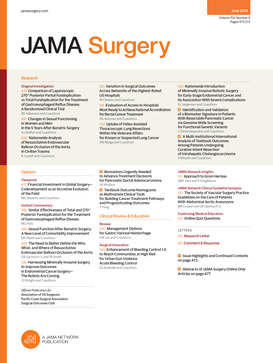Clinical Outcomes of Laparoscopic vs Robotic-Assisted Cholecystectomy in Acute Care Surgery.
IF 15.7
1区 医学
Q1 SURGERY
引用次数: 0
Abstract
Importance The use of robotic-assisted cholecystectomy in acute care surgery is increasing, but its safety and efficacy compared with laparoscopic cholecystectomy remain unclear. Objective To compare clinical outcomes and bile duct injury rates between robotic-assisted cholecystectomy and laparoscopic cholecystectomy in acute care surgery. Design, Setting, and Participants This was a retrospective cohort study using patient data from a commercial claims and encounter database from 2016 to 2021. Included in the study were adult patients undergoing robotic-assisted cholecystectomy or laparoscopic cholecystectomy in acute care surgery. Data were analyzed from January to October 2024. Exposures Robotic-assisted or laparoscopic cholecystectomy in acute care surgery. Main Outcomes and Measures The primary outcome was bile duct injury. Results A total of 844 428 patients (mean [SD] age, 45.6 [12.5] years; 547 665 female [64.9%]) were included in this analysis. After propensity score matching, robotic-assisted cholecystectomy (n = 35 037) and laparoscopic cholecystectomy (n = 35 037) had similar bile duct injury rates (0.37% [128 of 35 037] vs 0.39% [138 of 35 037]; odds ratio [OR], 0.93; 95% CI, 0.73-1.18; P = .54). Robotic-assisted cholecystectomy had higher major postoperative complications (8.37% [2934 of 35 037] vs 5.50% [1926 of 35 037]; OR, 1.57; 95% CI, 1.48-1.67; P < .001), more postoperative drain use (0.63% [219 of 35 037] vs 0.48% [132 of 35 037]; OR, 1.66; 95% CI, 1.34-2.07; P < .001), and longer median (IQR) hospital length of stay (3 [2-4] days vs 2 [1-4] days; P < .001). Conclusions and Relevance In this large, propensity-matched cohort analysis of acute care surgery cholecystectomy, robotic-assisted and laparoscopic cholecystectomy had similar bile duct injury rates, but robotic-assisted cholecystectomy was associated with higher postoperative complications, longer hospital stays, and increased drain use. Further research is needed to optimize the use of robotic-assisted cholecystectomy for acute gallbladder disease. These findings suggest that, under current practice conditions, robotic-assisted cholecystectomy may not offer clear benefits compared with the standard, established laparoscopic cholecystectomy approach.腹腔镜与机器人辅助胆囊切除术在急诊手术中的临床效果。
机器人辅助胆囊切除术在急诊手术中的应用越来越多,但与腹腔镜胆囊切除术相比,其安全性和有效性尚不清楚。目的比较机器人辅助胆囊切除术与腹腔镜胆囊切除术在急诊手术中的临床效果和胆管损伤发生率。设计、环境和参与者:这是一项回顾性队列研究,使用来自2016年至2021年商业索赔和遭遇数据库的患者数据。该研究包括在急诊手术中接受机器人辅助胆囊切除术或腹腔镜胆囊切除术的成年患者。数据分析时间为2024年1月至10月。机器人辅助或腹腔镜胆囊切除术在急诊手术中的应用。主要结局和措施主要结局为胆管损伤。结果共844例 428例患者(平均[SD]年龄45.6[12.5]岁;547例 665例女性[64.9%])纳入本分析。倾向评分匹配后,机器人辅助胆囊切除术(n = 35 037)和腹腔镜胆囊切除术(n = 35 037)的胆管损伤率相似(0.37%[35 037中的128人]vs 0.39%[35 037中的138人];优势比[OR], 0.93;95% ci, 0.73-1.18;p = .54)。机器人辅助胆囊切除术的主要术后并发症较高(8.37%[2934 / 35 037]vs 5.50%[1926 / 35 037];或者,1.57;95% ci, 1.48-1.67;P < 0.001),术后引流管使用率更高(0.63%[35例 037中的219例]vs 0.48%[35例 037中的132例];或者,1.66;95% ci, 1.34-2.07;P < 0.001),中位(IQR)住院时间更长(3[2-4]天vs 2[1-4]天;p < 0.001)。结论和相关性在这项大型的、倾向匹配的急性护理手术胆囊切除术队列分析中,机器人辅助胆囊切除术和腹腔镜胆囊切除术的胆管损伤率相似,但机器人辅助胆囊切除术与更高的术后并发症、更长的住院时间和更多的引流管使用相关。需要进一步的研究来优化机器人辅助胆囊切除术在急性胆囊疾病中的应用。这些发现表明,在目前的实践条件下,与标准的、已建立的腹腔镜胆囊切除术方法相比,机器人辅助胆囊切除术可能没有明显的好处。
本文章由计算机程序翻译,如有差异,请以英文原文为准。
求助全文
约1分钟内获得全文
求助全文
来源期刊

JAMA surgery
SURGERY-
CiteScore
20.80
自引率
3.60%
发文量
400
期刊介绍:
JAMA Surgery, an international peer-reviewed journal established in 1920, is the official publication of the Association of VA Surgeons, the Pacific Coast Surgical Association, and the Surgical Outcomes Club.It is a proud member of the JAMA Network, a consortium of peer-reviewed general medical and specialty publications.
 求助内容:
求助内容: 应助结果提醒方式:
应助结果提醒方式:


